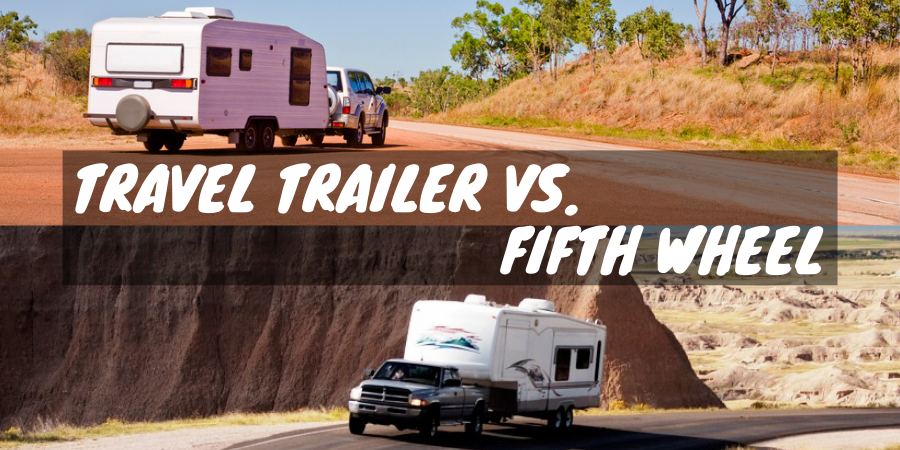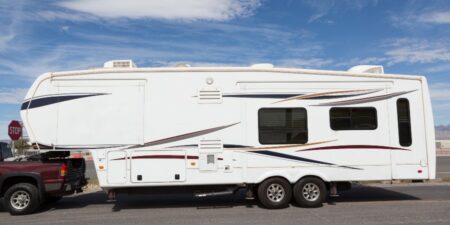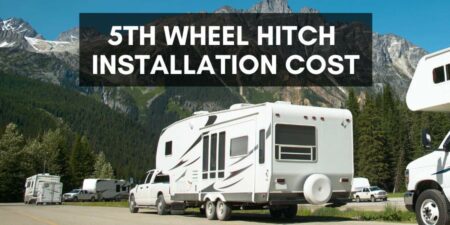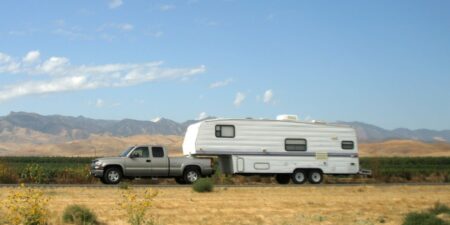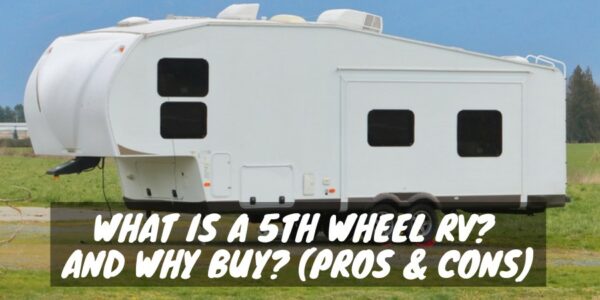Many people new to RVing don’t know fifth wheels and travel trailers are two different recreational vehicles. While both are towable trailers made for camping, many things make each unique that will impact your camping experience.
To better understand all the differences between travel trailers and fifth wheels, I put all the information in the guide below.
RVs are a serious investment, and buying the wrong camper can mean years of unnecessary frustration. If a towable camping trailer is on your shopping list, you’ll want to read to the end before you make a final decision!
Travel Trailer vs. Fifth Wheel Differences in Hitch and Towing
The way a travel trailer and a fifth-wheel camper hitch to a truck or vehicle for towing is the first major difference between the two types of recreational vehicles.
Travel Trailer Hitch and Towing Details
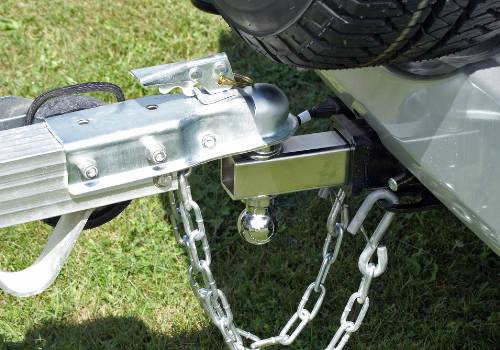
A travel trailer uses a ball hitch system that sits forward of the camper and is part of the camper’s framing.
The hitch can either be manually or hydraulically lowered and raised so you can hook on or off the tow vehicle.
The connection to the tow vehicle is on the rear bumper, so the camper’s total weight and length are behind the tow vehicle.
The configuration of the hitch system enables the full use of a truck’s bed for storage both during travel days and while at the campsite.
The towing of a travel trailer is not as straightforward due to the trailer’s turning radius and weight distribution on the hitch.
The addition of sway bars significantly increases control of the camper while driving to reduce vibrations and side-to-side movement from wind or quick lane changes.
Fifth Wheel Hitch and Towing Details
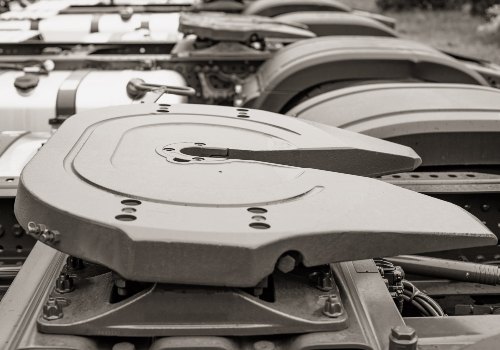
A fifth wheel (5th wheel) gets its name from the hitch system it uses.
The fifth-wheel hitch and coupling connect between the rear wheels of a heavy-duty truck, providing a “fifth” point of contact that distributes the camper’s weight.
The hitch connector on the trailer sits underneath the elevated front portion of the camper. The coupler is bolted to the truck bed floor, rendering that space useless for other storage during camping trips.
The hitch’s location over the truck tires makes it feel like you’re pulling less weight.
The hitch’s higher and more forward location also changes how the camper maneuvers during turns and when backing into campsites.
RVers who have experience with both types of campers say driving, parking, and hitching up is much easier with a fifth wheel.
Travel Trailer vs. Fifth Wheel Differences in Build
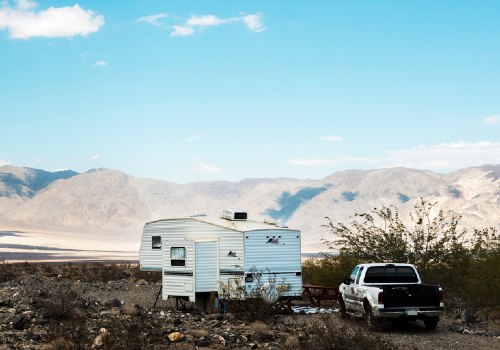
Once you look at a travel trailer and a fifth wheel set side by side, you’ll notice each has a distinct shape.
Let’s look at the stats so you can see what to expect when you tour a fifth wheel vs. a travel trailer.
Travel Trailer vs. Fifth Wheel Trailer Size Comparison
Travel Trailer Dimensions
Travel trailers can be anywhere from 10-40 feet in length with one to three sets of axles.
The average width of a travel trailer is eight feet. Some smaller towable trailers are as slim as six feet, but no travel trailer width exceeds 8.5 feet.
The exterior height of travel trailers ranges from nine to 11 feet, but none will be over 12 feet. The interior height of a travel trailer ranges between 6′ 8″ and 7′ 4″, but most of them are under 7-foot.
Travel trailers can have slideouts and models that typically have one or two at most.
A travel trailer’s hitch extends from the front of the trailer’s frame.
Fifth Wheel Dimensions

Fifth wheels start at around 19 feet in length and go up to 45 feet. Most fifth-wheel purchases are in the 30-40 foot range and have two to three axles.
But some crazy manufacturers are stretching the length limits even further, some going over 50 feet!
Don’t believe me? Check out this Spacecraft RV Manufacturing fifth wheel that is an astounding 57 feet long.
While a camper that massive requires a special tow vehicle and must meet the legal length restrictions set in certain states for road travel, all fifth-wheels need a truck to tow the trailer.
The fifth wheel width is between 8 and 8.5 feet, but some models push the 9-foot mark. There are more slideouts on a fifth-wheel camper, with three to five on most models.
The exterior averages 13 feet in height, but some manufacturers push this number to the 13.5-foot maximum most states allow for road travel.
The interior height will fall between seven and eight feet. The main living area will have the highest ceiling height, and the step-up above the hitch will be lower.
The size of fifth-wheels often requires a heavy-duty pickup truck to safely pull the camper, which is another consideration when comparing the overall cost of ownership.
The higher height of fifth-wheels can also pose a concern for RVers who travel off the beaten path. Unmarked low underpasses and low-hanging branches can do some damage.
Spacecraft RV Manufacturing 57 Foot Custom 5th Wheel RV Coach (Video)
Fifth Wheel vs. Travel Trailer Weight Comparison
Travel Trailer Weights
The average travel trailer weighs between 3,000-6,500 pounds.
The lightest travel trailers weigh around 1,500 pounds, while long toy haulers average 7,600 pounds. The largest travel trailers top out at around 11,500 pounds unloaded.
Small, ultra-lightweight travel trailers like teardrops or pop-ups often use a standard automobile, an SUV, or a light-duty truck to pull them to camping destinations.
Mid-size travel trailers require a 1/2-ton truck to pull most models up to 8,000 pounds. A 3/4-ton truck is best for travel trailers that weigh in the 7,500-10,000 pound range.
Large travel trailers or toy haulers will require a one-ton truck to pull more than 10,000 pounds.
Fifth Wheel Weights
The average weight of a fifth-wheel camper is 12,000-15,000 pounds.
The lightest fifth wheel weighs around 2,400 pounds, and the heaviest pushes the 20,000-pound range.
A lightweight fifth wheel typically weighs 7,000–9,500 pounds, enabling you to use a 1/2 or 3/4-ton pickup truck for towing.
A mid-size fifth wheel weighs between 10,000–14,000 pounds, which will require a one-ton truck for towing.
A full-size fifth wheel weighs between 11,000–20,000 pounds, requiring a one-ton or even a 1.5-ton truck for safe towing.
Travel Trailer vs. Fifth Wheel Floorplan Comparison
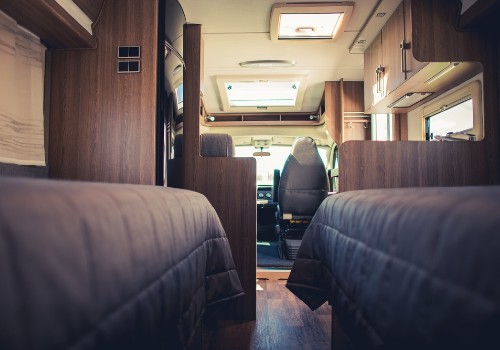
Travel Trailer Floorplan
The flat floor that runs the length of a travel trailer allows the camper to utilize a more extensive array of floorplans.
Most manufacturers still prefer to place the waste tanks, therefore the bathrooms, near the rear of the trailer.
Placing the kitchen near the center of the camper also reduces the drain piping needed to reach the grey-water holding tank.
Many large travel trailers have additional waste tanks to accommodate floorplans with two bathrooms.
Most travel trailer floorplans have the bed in the front near the hitch and heavier couches and kitchen appliances over the tires.
Slideouts are nearly always in the kitchen or living area for more floor space for hanging out. The floorplan will have a dinette and sofa that can be opened or converted into a bed when necessary.
Unless the trailer is tiny, bathrooms will have a separate toilet, shower, and sink.
Fifth Wheel Floorplan
A fifth-wheel floorplan is more attractive as they have two levels inside the camper, making it feel more like a home.
There will be a short hallway to the right when you enter the door that leads to a couple of stairs where you’ll find the master suite and a bathroom. This elevated area sits above the hitch, so the truck bed fits underneath.
In the central area of most fifth wheels will be the kitchen. Expect to see many models that have an island with a sink.
Most fifth-wheels feature a free-standing table and chairs over a dinette.
Some models also have an elevated rear floor, but all typically place the television and couches in this area. Expect to find ample seating around the perimeter of the living room.
Fifth wheels feel extra spacious inside due to the use of three or more deep slides. The master will nearly always have the bed in a slide, and both sides of the living area generally expand.
There’s also a slide in the kitchen seating area more often than not.
Travel Trailer vs. Fifth Wheel Trailer Storage Comparison
Travel Trailer Storage
Travel trailer exterior storage compartments are typically fewer in number and not as high or deep as in a fifth wheel.
Since the trailer floor is lower and the ceiling height shorter, there isn’t as much room to install basement storage.
Manufacturers know that storage is a selling point and manage to work in as many compartments of any size as they can. Many create a large pass-through underneath a couch or bed, so you don’t notice the missing space inside the camper.
Want to Connect With a Community of Over 1,078 RV Enthusiasts?
On the inside of a travel trailer, you’ll see that storage isn’t an issue. Upper cabinets surround the space wherever they’ll fit, and lower cabinets are abundant.
Dressers and closets in the master fit more belongings, and dinettes and beds lift on locking hinges for additional storage underneath.
Fifth Wheel Storage
Fifth-wheel interior storage is the same, if not a tad less than you’d find in a similar-length travel trailer.
The remarkable difference is in the basement storage you access from the exterior of the trailer. I have seen some pass-through compartments so large they could fit a twin bed and become another room.
With the higher ceilings and lifted floor of a fifth-wheel, there’s just much more room to install deep and tall storage bins.
Travel Trailer vs. Fifth Wheel Pros and Cons
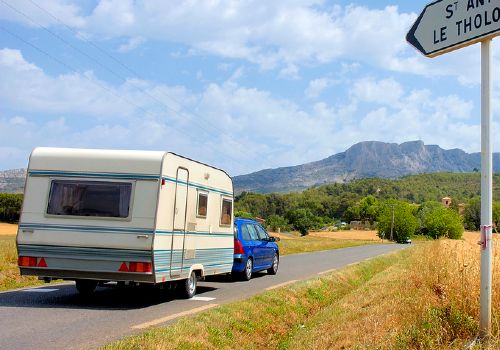
What do long-time owners have to say about what they love and what they dislike about their type of towable camping trailer?
I did a poll of all my RVing friends, many of whom have owned both types, about how type affects daily camping activities, and this is what they say:
Living Space
There’s nearly complete agreement that the fifth wheel feels like it has more living space because it offers more slideouts and has a much higher ceiling. For taller people, this difference is even more apparent.
The win for travel trailers is there’s no wasted “air” space, so the actions of daily camp living are more efficient.
Meal Prep
Overall, both travel trailer and fifth wheel owners think their kitchen works well for campground cooking. The key is to look for models with full-size appliances, islands, and outdoor kitchens if you love to cook.
Outdoor Entertaining Space
Most RVers love to spend hours hanging out on the campsite patio. Both types of RVs have awnings covering the central area outside the camper door.
The difference travel trailer owners notice most is that the awnings on their campers are lower, and the width can vary widely from model to model.
Many travel trailers still have manual awning systems that take extra time to open, close, and secure.
Fifth wheels are much taller, putting the awning attachments out of reach for manual operation, so manufacturers use electrical versions.
Pushing a button is an absolute joy when you need to pull in the awning quickly during bad weather. Fifth-wheel awning roofs are also higher and have no support legs, so the outer edge is free of obstacles.
Most large fifth-wheels have a second awning for full coverage down the length of your camper for making separate eating and hanging out spaces.
The only downfall of the fifth-wheel awning is the more limited coverage because the numerous slides take up part of the livable patio space.
Travel Days
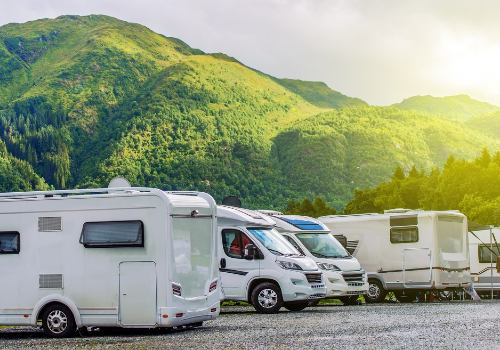
Fifth wheels offer more towing control, alleviating a lot of travel stress, but watching out for height restrictions on roads and gas stations is a genuine concern. The camper also weighs much more than a travel trailer, so expect your fuel costs to be higher.
Travel trailers require the right truck and sway bars for optimal towing control, but once you have them, you can enjoy fuel savings, and no worries, your camper roof or air conditioner will get sheared off under a low bridge.
Travel trailers with one or no slides make popping in during rest breaks to eat or use the bathroom simple. Fifth wheels are very tight inside when the slides are in, making it challenging to use until set up at the campground.
Boondocking
Fifth wheels typically have the biggest holding tanks, battery bank, and inverter, so, in theory, they are better for longer boondocking RV trips.
Their downfall is that the bulky body shape and weight make it awkward to pull down uneven and often muddy dirt or gravel side roads. Setting up on bare ground can also be a problem, as the heavier weight pushes the jacks and blocks into the soil.
Lighter travel trailers perform well during dry camping excursions, and owners love how they can tuck small units easily into a shady nook under the trees.
Final Thoughts
Personal comfort and taste will have RV shoppers leaning toward a particular fifth-wheel or traditional travel trailer model, but there’s more to camping than RV looks and features.
Bigger is not necessarily better, and luxury amenities won’t help you get unstuck from tight situations.
I hope this article clarifies the differences between travel trailers and fifth wheels in design, tow ability, and real-life use and helps you decide which type of RV is best for your needs!
Trailer or Fifth Wheel? (Video)
"Man cannot discover new oceans unless he has the courage to lose sight of the shore."
-- Andre Gide

